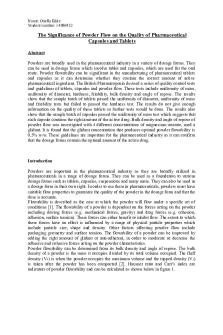Capsules - notes PDF

| Title | Capsules - notes |
|---|---|
| Course | Extemporaneous Compounding |
| Institution | St. John's University |
| Pages | 1 |
| File Size | 39 KB |
| File Type | |
| Total Downloads | 28 |
| Total Views | 161 |
Summary
notes...
Description
Capsules o As a pharmacist you are making mostly capsules and powder o From the email remember conversion of grains and gram o Capsula small box (easy version of tablet) Can be filled by machine or hand Most are available as gelatin capsule some are plant based capsules Hard gelatin capsule dry powders, semi-solids, and liquid (exceptions) Soft gelatin capsule oil o Requires a special machinery Iron content must be less than 15 ppm (due to the gelatin) Bubble method has no seam on it (generated from the drop) Not largely used because not good for large scale production o Advantages of capsule dosage forms Easy to swallow (compared to tablet) Capsules can have a variety of colors (identification purposes) Easy to mask unpleasant taste because the shell has no taste Separate capsules for incompatible powders versus bilayer tablet o Disadvantages Easily tampered How can tampering of a capsule be prevented? Effects of humidity and microbial contamination Some people have difficulty swallowing More expensive o Alternative to gelatin HPMC Mallard reaction Hydrophilic polymer No ionized group no cross-linking concerns More costly than gelatin capsules Chemoreceptor trigger zone related to nausea and vomiting of the brain o Capsule sizes The amount of powder that an empty hard gelatin can hold depends on three factors: Volume of fill material Density of the powder Compressibility of fill material Sizes for human 5-0 (small to big) Rule of Six (need to know how change grain to gram) 1 grain = 65 mg For this rule the density of the powder must be 0.6 mg/mL Rule of Seven Is not based on the density of the powder...
Similar Free PDFs

Capsules - notes
- 1 Pages

Capsules - Lecture notes 1-4
- 19 Pages

Title: Pharmaceutical Capsules
- 1 Pages

Notes
- 18 Pages

Notes
- 12 Pages

Notes
- 61 Pages

Notes
- 35 Pages

Notes
- 19 Pages

Notes
- 70 Pages

Notes
- 6 Pages

Notes
- 35 Pages
Popular Institutions
- Tinajero National High School - Annex
- Politeknik Caltex Riau
- Yokohama City University
- SGT University
- University of Al-Qadisiyah
- Divine Word College of Vigan
- Techniek College Rotterdam
- Universidade de Santiago
- Universiti Teknologi MARA Cawangan Johor Kampus Pasir Gudang
- Poltekkes Kemenkes Yogyakarta
- Baguio City National High School
- Colegio san marcos
- preparatoria uno
- Centro de Bachillerato Tecnológico Industrial y de Servicios No. 107
- Dalian Maritime University
- Quang Trung Secondary School
- Colegio Tecnológico en Informática
- Corporación Regional de Educación Superior
- Grupo CEDVA
- Dar Al Uloom University
- Centro de Estudios Preuniversitarios de la Universidad Nacional de Ingeniería
- 上智大学
- Aakash International School, Nuna Majara
- San Felipe Neri Catholic School
- Kang Chiao International School - New Taipei City
- Misamis Occidental National High School
- Institución Educativa Escuela Normal Juan Ladrilleros
- Kolehiyo ng Pantukan
- Batanes State College
- Instituto Continental
- Sekolah Menengah Kejuruan Kesehatan Kaltara (Tarakan)
- Colegio de La Inmaculada Concepcion - Cebu




